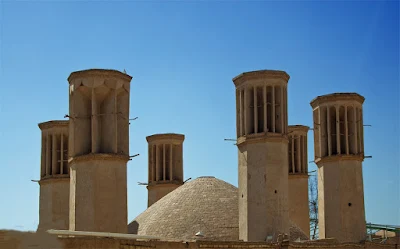Most of cistern so called Ab-anbar which means water storage
is a sustainable traditional water supply system in a hot arid regions and is a
remarkable example of Iranian vernacular architecture. It is the traditional
type of reservoir that was commonly built in pre-modern Iran. Yazd is known for
its adobe architecture, Zoroastrian fire temples and tall structures known as
badgirs, or wind-catchers, which in ancient times functioned as natural
ventilation in large buildings. The city as the historical and desert part of
the country contains several Ab-Anbar. These structures are usually located in
the center of the city made up of main parts: the underground reservoir, the
platform, and the dome and six wind catchers. Ab-Anabr-e-Shesh badgiri is one
of the oldest water storage in Yazd which is located in the Tel district. The
building has two entrances with 55 steps in the north and south. The most
outstanding feature of this structure is the arch by brick facade and large
roof water storage tank which was built by Haji Hussein Mirallah in 1379 AH. The
ancient city of Yazd in central Iran has become the country's 22nd world
heritage site.
 |
| Ab-Anabr-e-Shesh badgiri , Yazd, Iran |

No comments:
Post a Comment